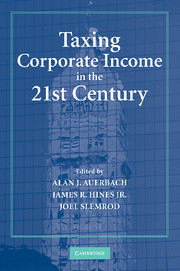Book contents
- Frontmatter
- Contents
- Contributors
- Preface
- 1 The Effects of Taxes on Market Responses to Dividend Announcements and Payments: What Can We Learn from the 2003 Dividend Tax Cut?
- Comments
- Comments
- 2 Dissecting Dividend Decisions: Some Clues about the Effects of Dividend Taxation from Recent UK Reforms
- Comments
- Comments
- 3 The 2003 Dividend Tax Cuts and the Value of the Firm: An Event Study
- Comments
- Comments
- 4 How Elastic Is the Corporate Income Tax Base?
- Comments
- Comments
- 5 An Empirical Examination of Corporate Tax Noncompliance
- Comments
- Comments
- 6 On the Extent, Growth, and Efficiency Consequences of State Business Tax Planning
- Comments
- Comments
- 7 Corporate Taxation and International Competition
- Comments
- Comments
- 8 The Changing Role of Auditors in Corporate Tax Planning
- Comments
- Comments
- 9 Taxation and the Evolution of Aggregate Corporate Ownership Concentration
- Comments
- Comments
- Index
- References
7 - Corporate Taxation and International Competition
Published online by Cambridge University Press: 30 July 2009
- Frontmatter
- Contents
- Contributors
- Preface
- 1 The Effects of Taxes on Market Responses to Dividend Announcements and Payments: What Can We Learn from the 2003 Dividend Tax Cut?
- Comments
- Comments
- 2 Dissecting Dividend Decisions: Some Clues about the Effects of Dividend Taxation from Recent UK Reforms
- Comments
- Comments
- 3 The 2003 Dividend Tax Cuts and the Value of the Firm: An Event Study
- Comments
- Comments
- 4 How Elastic Is the Corporate Income Tax Base?
- Comments
- Comments
- 5 An Empirical Examination of Corporate Tax Noncompliance
- Comments
- Comments
- 6 On the Extent, Growth, and Efficiency Consequences of State Business Tax Planning
- Comments
- Comments
- 7 Corporate Taxation and International Competition
- Comments
- Comments
- 8 The Changing Role of Auditors in Corporate Tax Planning
- Comments
- Comments
- 9 Taxation and the Evolution of Aggregate Corporate Ownership Concentration
- Comments
- Comments
- Index
- References
Summary
Introduction
Many countries tax corporate income heavily despite the incentives that they face to reduce tax rates in order to attract greater investment, particularly investment from foreign sources. The volume of world foreign direct investment (FDI) has grown enormously since 1980, thereby increasing a country's ability to attract significant levels of new investment by reducing corporate taxation. The evidence indicates, however, that corporate tax collections are remarkably persistent relative to gross domestic product (GDP), government revenues, or other indicators of underlying economic activity or government need. If this were not true – if corporate income taxation were rapidly disappearing around the world – then such a development might be easily explained by pointing to competitive pressures to attract foreign investment and retain domestic investment. Hence, the question remains why growing international capital mobility has not significantly reduced reliance on corporate income taxation.
There are at least three possible resolutions of this puzzle, of which the simplest is that the continued taxation of corporate income at high rates reflects the politics of tax policy formation. Corporate taxation may be popular because its incidence is so uncertain, leading large numbers of voters and various interest groups to conclude that others, and not they, bear the burden of this tax. If this political phenomenon is important, then it would explain why greater international capital mobility might not be accompanied by sharp tax reductions around the world.
- Type
- Chapter
- Information
- Taxing Corporate Income in the 21st Century , pp. 268 - 295Publisher: Cambridge University PressPrint publication year: 2007
References
- 28
- Cited by



